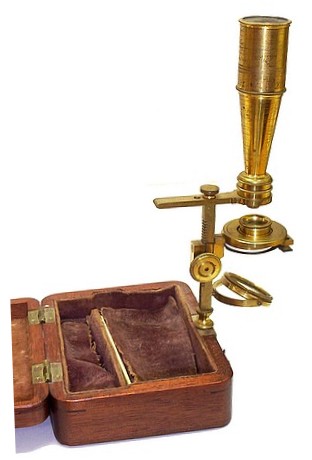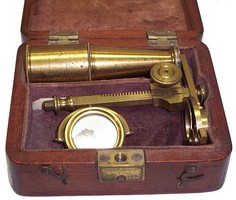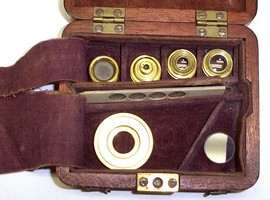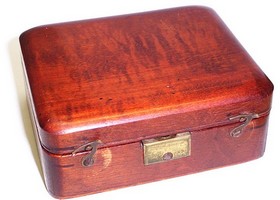Although this microscope is unsigned by the maker,
it is identical to examples signed Cary, London.
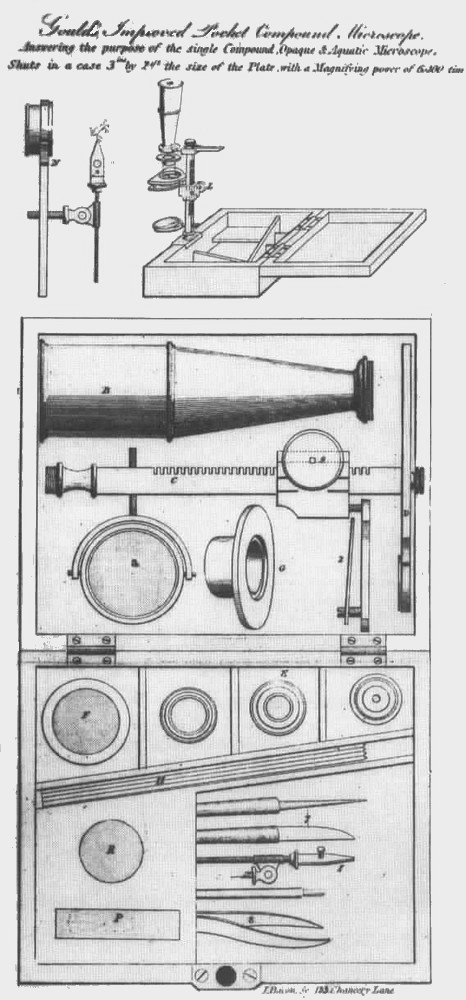
Gould's Improved Pocket Compound
Microscope. (Fig. 754, next page). The
extreme portability and great magnifying power of
this microscope will recommend it strongly to the
naturalist, mineralogist, and botanist, as it has
sufficient powers to discover minute animalcules and
seed-vessels. It combines the uses of the single,
compound, opaque, and aquatic microscopes; and has
been found, upon comparison, by several scientific
gentlemen, superior in power to, and more distinct,
than many of the larger and more expensive
instruments of the kind. It shuts up in a case, three
inches by three and a half, and may be carried in the
pocket without the slightest inconvenience.
Description of the Plate. A: The microscope,
as it lies in its case, the body and pillars taken
out, to show the apparatus beneath. B, the compound
body. C, the pillar on which is fixed the stage, fig.
2, and reflecting mirror, fig. 3. These remain on the
pillar when put into the case, for the convenience of
packing. D, the arm, may be taken off and used as a
hand microscope, fig. N. E, the different powers,
Nos. 1, 2, 3. These are screwed on to the arm, and in
them the body, but each may be used singly for large
or opaque objects without the body. Nos. 1 and 2 may
be combined: No. 3 is not to be combined with either,
but used singly; the No. 4, in the small flat cell,
is the higher power, and is to be used with or
without the body for extremely minute transparent
objects. F, the object-box, which unscrews to place
live objects in, such as mites from cheese; this is
placed on the stage. G, a movable piece, to place on
the stage, fig. 2, for holding objects. H, slides
filled with curious objects. I, a pair of
steel-pointed forceps, which open by pressing the two
brass pins, for holding flies, or pieces of card with
opaque objects on them; this is placed in the hole on
the stage or on the arm, when used as a hand
microscope, fig. N. K, a dissecting-knife and point;
a pair of brass forceps, for taking up small objects,
with a spoon at the end for taking up a single drop
of water, for placing between the two glasses to view
the animalcule; a small brush for taking the mites
from cheese, farina from flowers, and other delicate
objects. L, the whole instrument put together for
use. N, the arm converted into a hand-microscope. P,
two pieces of glass sealed together for holding a
drop of water. R, a circular piece of glass for
placing on the stage G, to hold any object.
Directions for putting the Microscope
together. First take out the pillar, on which is
fixed the stage and reflecting mirror; screw it on
the brass-piece on the side of the box; turn the
mirror to face the light, and move the stage to the
centre of the pillar by means of the rack and pinion;
place one of the powers on the body, and screw it
into the arm : you must now get a clear and distinct
field; this you will obtain by moving the mirror to
the proper angle to reflect the light, at the same
time looking through the microscope; now place the
object to be examined on the stage; get the proper
focus of the lens by moving the stage up and down by
means of the milled-head, fig. 9. To place the slides
in the stage, press down with the fingers the brass
spring underneath; as an improvement for viewing
objects generally, the movable piece, G, is placed
upon the fixed stage, fig. 2; it may be moved by the
finger and thumb, with the greatest delicacy, in any
direction; the object to be examined being placed
upon the circular piece of glass. 'To place the
pillar again in the case, let the stage be brought
close up to the arm, and the mirror turned round;
they will then fit into their place without being
separated from the pillar. It is more difficult to
get the reflected light with the candle than by day
light, but many of the objects appear to much greater
advantage; the candle should be placed at the
distance of about twelve inches, not too high, and in
a straight line with the mirror.
Description and Application of the Different
Powers. This microscope has five different
powers, so arranged that objects may be viewed from
the size of a large beetle or moth to the most minute
animalculee. These powers are marked Nos. 1, 2, 3;
No. 1 is the lowest power, and is calculated for
viewing opaque and large objects, and should be used
without the body. No. 2 is the next power, and is
calculated for viewing all the objects of the size of
those in the slides; the next power is produced by
combining the Nos. 1 and 2 together, which may be
called the third power; it magnifies 2,500 times, and
is adapted for viewing the animalculee, &c. The
fourth power is in a conical cell, marked No. 3; with
this power an object is magnified 26,000 times with
the body; the fifth or greatest power is in a flat
cell, and magnifies an object 62,500 times with the
body, which is equal to the largest compound
microscopes; it should only be used for extreme
minute objects, and without either of the other
powers; as the object and the lens come extremely
near when it is used, care must be taken, by a very
delicate movement of the stage, that they do not come
in contact with each other in getting the proper
focus. To prevent this, if a drop of water is to be
examined, place it between the slips of glass, and if
these will not permit the lens to come near enough,
place a piece of thin talc upon a piece of glass.
Objects should first be viewed with the low powers,
that the whole of them may be seen, and the higher
ones can then be used in gradation.
